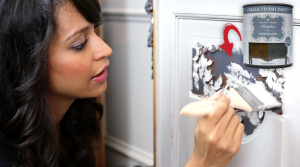Amitha's Blog
How to Get the Perfect Chippy, Distressed Look [Video Tutorial]
You guys! It’s 2020! I sure hope you’re as excited as I am!
A new year always inspires me to sit down for a moment and think about all the new things I want to accomplish, learn and experience over the next several months.
I recently started writing down a list of all the new things I want to achieve this year. In particular, I’m really looking forward to learning some new recipes, understanding better how to use my Instant Pot, and finding out all the cool things my iPhone can do for me.
The cooking one is really important to me because, to put it bluntly, I’ve been stuck in a rut! I tend to stick to a few key recipes, and frankly hubby Bobby, and my boys Rohan and Devan are seriously getting tired of them! (I can’t say I blame them!)
It’s funny, in an ironic sort of way, that when we’re chalky painting our furniture projects, we tend to do the same – stick with the same colors and techniques that we’re used to and have become comfortable with.
And to be honest, I didn’t even realize this was the case until one of my long-time customers came into Village Antiques looking for help with a project.
Right before the Christmas holiday, Brenda came in and told us she was totally stumped. She wanted to achieve a certain look with her piece of furniture, but she could not for the life of her figure out how to make it happen.
What she was ultimately looking for was that chippy, distressed style of painting for her buffet. She wanted it to appear as if the piece had been fully painted, but then over time, parts of the paint finish had become faded, or started to chip away.
So, she brought it in and asked my team for help.
I’m so glad she did, because this was something that we know how to do and absolutely love doing, but we don’t typically do since most of the projects we work on are typically based on our clients’ desires and personal preferences.
I’ll admit, what she was trying to do is a bit complicated. And because of that, it’s very, very easy to mess up.
So to make sure she got the best results, I shared the technique that I use to guide similar projects along to success.
As I was showing Brenda and my team how to achieve this look, we decided to take a quick video so we could share the lesson with all of you as well.
In this fun and informative video tutorial, you will learn exactly how to achieve the same chippy, distressed painted finish style that Brenda was looking for.
I’ll give you a hint: the big mistake she was making was whitewashing the piece. In other words, she was adding water to her paint and then applying it to her buffet. This is a common mistake many people make. And a big no no for the look she wanted to achieve.
Unfortunately, using this approach will create a completely different look, which was the roadblock Brenda was running into.
What she didn’t realize was that, in order to achieve the chippy, distressed chalk painted style she was after, you actually have to start with a full coat of paint covering the entire piece.
This can be loosely done, meaning it does not need to be perfect.
I would suggest sticking to straight continuous brushstrokes (my painting mantra), but keep in mind that you don’t have to get every edge, nook and cranny perfectly coated, so feel free to have some fun with it.
Once that is dry, you can then start taking the paint off.
To do this, you can use either a 120 or a 180 grit sandpaper. (You can see the exact one I used in my video.)
How do you know how much paint to take off? Honestly, that’s totally up to you. It really depends on the type of end result you are trying to achieve.
If you want it super chippy, take off more.
If not, take off less.
Where do you take it off? The video tutorial will show you the hack that I use to guide myself along the project, but here’s the gist of it:
When you’re working on a huge piece like a buffet, it can be incredibly overwhelming.
That’s why I recommend mapping it out.
Start by taking a picture of your piece, then print it out and mark it up with the places you want to remove the paint. (I recommend doing this exercise with a pencil. That way if you don’t like it, you can just erase it and start over.)
Trust me – it’s much easier to figure it out on paper first than it is to wing it on the actual piece – especially if it’s a large piece, like a buffet.
In the video, you’ll discover:
- An incredibly gorgeous style that you’re sure to love
- The simple secret to making a complex project much easier
- Step by step instructions on how I accomplished the look, from start to finish
Now, over to you. What do you think about this style?
If this style is for you, what piece can you imagine doing this on in your home?
Be sure to leave a comment and let me know!
This is a great way to refresh an existing piece that you already have in your home, just like Brenda did. It’s also a fabulous way to kick off a new year AND a new decade!
Plus, you’ll get to check one thing off on your New Year’s resolution list: learning something new!
Wishing you and yours a very happy, healthy and creative 2020.
Here’s to accomplishing some of our dreams and goals together!
Cheers,
Amitha
P.S. You can find Amitha Verma Chalk Finish Paint at Village Antiques and retailers all throughout the US. So why wait? Why not get started on a project like this today? And remember to share a pic of the finished product so we can all enjoy it!

Secret Tool Revealed
High-priced interior decorators desperately want this hidden: YOU can transform your home into a gorgeous dwelling—all by yourself—and save thousands. All you need is a few dollars’ worth of material. Access this amazing secret RIGHT NOW, and revitalize your home...in just a few hours.





